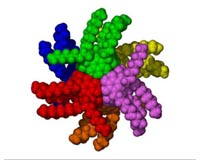 |
Manhattan KS (SPX) Jul 17, 2009 A Kansas State University student is combining engineering and nature to design a more affordable and more sustainable lighting source for those living without electricity. Tai-Wen Ko, K-State senior in electrical engineering, is mentoring Justin Curry, K-State freshman in electrical engineering. The pair is designing a solar lantern with a more affordable initial cost. Ko is focusing his efforts for people living in Sub-Saharan Africa, which he said is the least electrified region in the world. Ko said kerosene lamps are the most affordable option for people without electricity, but the lamps can be expensive to maintain and they produce carbon dioxide, which contributes to global warming. He said solar lanterns are a popular alternative to kerosene lamps because they run on renewable energy and aren't at risk of starting a fire. "Solar lanterns are not hard to make," Ko said. "You have to find the right parts and have ideas on how to build a circuit. I wanted to make a design that would be easy enough for someone living in Sub-Saharan Africa to build on their own, which would lower the cost because they wouldn't have to have it shipped." Ko said his solar lantern has three main components: a solar panel, battery and a white light-emitting diode. He researched different types of these materials and chose the cheapest options. Ko said his lantern is about 30 percent cheaper than the average market value. Most solar lanterns available use florescent tubes, which draw too much power, Ko said. He decided to use a white light-emitting diode because it's cheaper, lasts longer and is brighter. He chose the cheapest option for his solar panel and also for his battery, which is a sealed lead-acid battery and is similar to a car battery. Ko said an environmental concern for his lantern is that the battery contains lead, so he is researching a recycling plan that could be implemented in the Sub-Saharan African region. A lithium ion battery would be better for the environment, Ko said, but its current cost is expensive. Share This Article With Planet Earth
Related Links Kansas State University Powering The World in the 21st Century at Energy-Daily.com
 New Geothermal Heat Extraction Process To Deliver Clean Power Generation
New Geothermal Heat Extraction Process To Deliver Clean Power GenerationRichland WA (SPX) Jul 17, 2009 A new method for capturing significantly more heat from low-temperature geothermal resources holds promise for generating virtually pollution-free electrical energy. Scientists at the Department of Energy's Pacific Northwest National Laboratory will determine if their innovative approach can safely and economically extract and convert heat from vast untapped geothermal resources. The goal ... read more |
|
| The content herein, unless otherwise known to be public domain, are Copyright 1995-2009 - SpaceDaily. AFP and UPI Wire Stories are copyright Agence France-Presse and United Press International. ESA Portal Reports are copyright European Space Agency. All NASA sourced material is public domain. Additional copyrights may apply in whole or part to other bona fide parties. Advertising does not imply endorsement,agreement or approval of any opinions, statements or information provided by SpaceDaily on any Web page published or hosted by SpaceDaily. Privacy Statement |